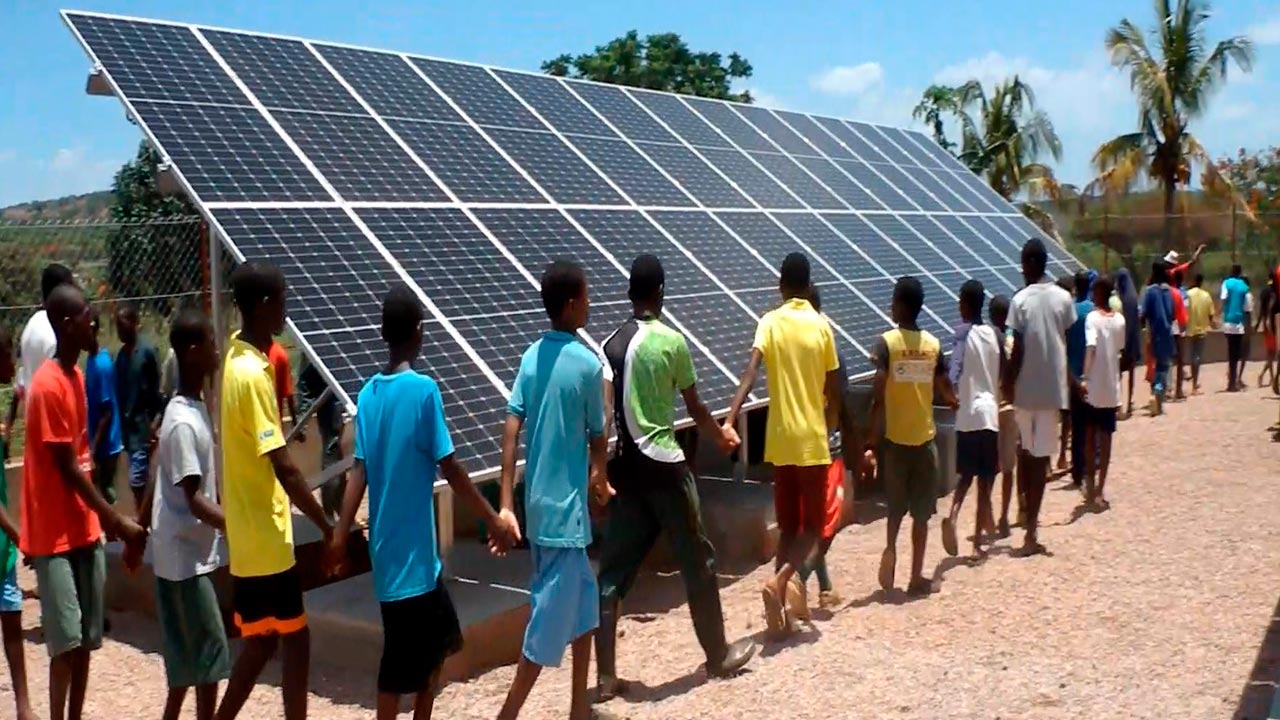Completion of the Second Phase of the Solar Energy Project at the Casa do Gaiato Farm in Mozambique
Completion of the Second Phase of the Solar Energy Project at the Casa do Gaiato Farm in Mozambique
The solar energy project for the Fazenda de Casa do Gaiato area has culminated in an on-ground photovoltaic installation that provides the agricultural area managed by the host house with an affordable, reliable and sustainable electricity supply. It is now fully operational.
The main objective of the project was to solve the problems arising from the grid electricity supply, which was of low quality, expensive and unreliable. The photovoltaic solar installation now powers the water pumping system, the chicken coop and the lighting of the agricultural area, significantly reducing the organization’s electricity bill and allowing reinvestment in new activities and projects for the benefit of the community.
Casa do Gaiato, located on the outskirts of the village of Massaca, in the district of Boane, Maputo province, has been a pillar of social support for the surrounding rural communities for more than 30 years. This organisation provides food, healthcare, education and vocational support to children without families, as well as primary and secondary education.
La instal·lació del sistema solar fotovoltaic ha estat realitzada amb èxit. Podeu consultar les dades a la fitxa de projecte. (link) Això ha permès a Casa do Gaiato ser més autosuficient pel que fa al subministrament elèctric i estalviar diners per finançar altres activitats de la fazenda.
Beneficis Assolits
- Estalvi Econòmic: Hem aconseguit una reducció significativa dels costos d’electricitat, permetent un ràpid retorn de la inversió.
- Sostenibilitat Ambiental: S’ha reduït l’ús de combustibles fòssils i les emissions de CO2.
- Millora de la Productivitat: Les activitats agrícoles són ara més rendibles gràcies a una font d’energia fiable.
- Impacte Social: Les condicions de vida dels nens/es, treballadors/es i famílies associades a Casa do Gaiato esperem que millorin notablement.

In addition to the installation of the system, practical training has been provided to Casa do Gaiato workers to ensure the long-term sustainability of the system. With these trainings we hope to increase the local capacity of the maintenance of the facilities in order to optimize the energy produced.
We are very satisfied with the results of this second phase of the project. Casa do Gaiato can now carry out all its agricultural and economic activities without interruptions or large expenditures on fossil fuels. This success not only benefits the organization, but also contributes to a more sustainable and equitable future for the entire community.
For this reason, we want to thank all those who have participated and collaborated in this project. To our team formed by Chloé for the coordination and Jordi who is already one more “gaiato”!


Azimut World: cooperation and development area
Key Challenges of Photovoltaics: Causes, Impact, and Prevention
Key Challenges of Photovoltaics: Causes, Impact, and Prevention

When a photovoltaic installation operates optimally, ensuring a safe and reliable electricity supply, it can become a large-scale power source. However, photovoltaic technology faces major daily challenges in terms of quality, installation, operation, and decommissioning. Below, we describe five main challenges facing photovoltaic technology:
Derating
What is Derating?
Derating refers to the power reduction in photovoltaic inverters caused by environmental factors such as heat, altitude, and voltage. In extreme situations, this phenomenon can even stop production. This effect is especially noticeable in areas with high temperatures.
Causes of Derating
The main causes of derating are:
- Temperature: When inverters generate heat while converting direct current (DC) into alternating current (AC) and the ambient temperature is high, the inverters reduce their power to protect internal components.
- Altitude: At high altitudes, the low air density facilitates ionization at high voltages, affecting inverter performance.
- DC voltage: Maintaining the proper operating voltage range is essential to avoid derating.
How to Prevent Derating
To avoid it, several actions can be taken:
- Proper installation: Follow the manufacturer’s recommendations for ventilation and avoid direct sun exposure.
- Quality of equipment: Choose high-quality inverters with efficient ventilation systems, either by convection or forced ventilation.
- Regular monitoring: Conduct periodic inspections to ensure optimal performance.
LID Effect (Light-Induced Degradation)
What is the LID Effect?
The LID effect refers to the degradation of photovoltaic modules caused by chemical reactions in silicon cells, leading to a loss of power and efficiency during the first months of solar exposure. This can result in a reduction of up to 10% of the initial power.
Causes of the LID Effect
The main cause of this effect is the reaction of boron with elements such as oxygen, iron, or copper present in the silicon cell. While boron is crucial for generating electricity, these reactions reduce electron flow, affecting the module’s efficiency.
Monocrystalline P-type modules are especially vulnerable to LID due to the difficulty in completely eliminating oxygen during the manufacturing process. In contrast, N-type cells, doped with phosphorus, show greater resistance to this effect.
How to Prevent the LID Effect?
- Applying high temperatures and currents.
- Using advanced technologies such as lasers or LEDs.
- Eliminating oxygen within the cell, though this is costly.
- Replacing boron with gallium.
Hotspot
What is a Hotspot?
A hotspot is a localized area within a photovoltaic module that overheats, potentially damaging the module or, in extreme cases, causing a fire. This issue arises from high resistance in a specific area, turning it into an electricity consumer that generates heat, exceeding 200°C.
Causes of Hotspots in Photovoltaic Modules
Hotspots can be caused by internal defects, shading, broken solder joints due to poor manufacturing, or improper handling. Other factors include accumulated dirt and permanent obstacles like trees or chimneys.
Prevention of Hotspots
- Choose materials from recognized brands with certified manufacturing processes.
- Ensure proper transportation of the modules.
- Follow the manufacturer’s instructions during installation.
- Regularly clean the modules according to site conditions.
- Conduct periodic inspections with specialized equipment.
Delamination
What is Delamination?
Delamination refers to the loss of adhesion between the different layers that make up a photovoltaic module. This defect can appear shortly after installation but may worsen over the module’s lifetime.
Causes of Delamination in a Photovoltaic Module
Delamination is usually associated with poor manufacturing or the use of low-quality materials. Additionally, improper transportation and handling during installation increase the likelihood of delamination. Environmental factors such as temperature, humidity, and UV radiation accelerate this process, especially in lower-quality modules.
Detection and Prevention of Delamination
Delamination can be identified through visual inspection, observing color changes in the module, white spots on the front, or bubbles on the back.
How to Prevent Delamination?
- Purchase materials from trusted brands with certified manufacturing processes.
- Ensure proper transportation, keeping the modules palletized and free from additional weight.
- Handle the modules carefully during installation, following the manufacturer’s recommendations.
- Periodically inspect the plant, performing visual checks and using specialized equipment at least once a year.
How Does Delamination Affect Photovoltaic Modules?
When delamination occurs away from the module’s edge, it can affect performance without posing an immediate safety risk. However, if delamination spreads to the edges, it can allow air and moisture to enter, leading to corrosion and irreversible deterioration of the module, which puts the plant’s integrity at risk.
LeTID Effect (Light and Elevated Temperature Induced Degradation)
What is the LeTID Effect?
The LeTID effect is a phenomenon that affects photovoltaic modules, particularly those using PERC cells. Discovered in 2012, it causes a power loss due to sunlight exposure, similar to LID, but occurs at operating temperatures above 50°C, whereas LID occurs at lower temperatures.
Causes of the LeTID Effect and How It Is Detected
Research points to hydrogen as the main culprit. During the cell manufacturing process, hydrogen atoms diffuse from other layers into the active area of the cell. High temperatures in the manufacturing process increase this diffusion, raising the risk of LeTID.
This issue is not visible to the naked eye, as LeTID is detected through an abnormal drop in panel performance. To confirm it, after ruling out other defects such as hotspots or delamination, electroluminescence equipment is used, just like with LID.
Preventing the LeTID Effect
Manufacturers and laboratories are working to better understand and mitigate the effects of LeTID. Some preventive measures in the manufacturing of PERC cells include:
- Using materials with low hydrogen content.
- Reducing temperatures during cell treatment.
- Using thinner wafers.
What You Need to Know
To prevent the effects of LID, hotspots, delamination, LeTID, or derating, it is crucial to carefully select both materials and manufacturers, optimize wafer treatment processes, and apply proper practices in transportation, installation, and maintenance of photovoltaic modules. Preventing and detecting these defects not only ensures greater efficiency and a longer lifespan for installations, but also provides significant long-term economic benefits.
In conclusion, the photovoltaic industry faces complex challenges that affect the durability and performance of installations. However, by using high-quality materials, applying advanced technologies, and ensuring proper maintenance, it is possible to mitigate these issues and ensure that installations operate optimally. At Azimut360, we work to provide comprehensive, tailored solutions for preventing and detecting these defects, ensuring that our clients’ photovoltaic installations not only maximize their efficiency but also extend their lifespan, generating sustainable economic benefits in the long term.

